
Stereophile - December 2020
Analog Corner
SAT's remarkable XD1 record-player system
SAT XD1: The Best 'Table Ever?
Michael Fremer, Insider views on everything vinyl
Let's begin by discussing what SAT's XD1 Record Player System is not: It is not a Technics SP-10R in a sci-fi–inspired plinth—although the XD1's engine does begin life as the SP-10R's basic drive system, which is stripped down to a handful of essential components, reimagined, reengineered, and rebuilt to much higher mechanical standards.
Marc Gomez, SAT's designer, holds a master's degree in mechanical engineering and materials science. Before dedicating himself to creating the SAT tonearm—by far the finest sounding and performing arm I've yet encountered (as unanimously corroborated by Stereophile readers who bought this very expensive product unheard as a result of my review)—he was involved in a variety of projects for, among others, the European Space Agency and various European automobile manufacturers.
Even if it's not broken, why not fix it?
The XD1 is a compact disc player, though not a player of compact discs (footnote 1).
Its sculpted, satiny beauty goes beyond skin deep. The XD1's metalwork, and that of the SAT tonearms, is machined at a Swedish workshop that makes parts for Hasselblad cameras.
Gomez says that in designing the XD1, he focused on four main areas: isolation from external disturbances, speed stability, rigidity, and vacuum hold-down.
When Mr. Gomez began conceptualizing his design a decade ago, it was immediately clear to him, he says, that direct drive was the best way to spin a platter. His reasons were these: A direct-drive motor's rotational speed is just 33.3, 45, or 78rpm compared to several hundred rpm's required in the typical belt-drive design, and with direct drive the spindle is not laterally loaded as it is in belt-drive designs, so it receives only torque, not an off-center force. The amount of torque available means the 'table is less likely to drag during heavily modulated passages, something direct-drive advocates claim happens with most belt designs.
Gomez says the drive-unit is no an off-the-shelf motor designed for generic industrial applications. Rather, it is conceived and built from the ground up to drive the XD1 (except for those few elements he kept from the SP-10R motor, footnote 2). He says it's better balanced than the motors typically used on belt-drive and idler turntables.
These claims are hardly novel: If your old Technics SL-1200, which also uses a direct-drive motor, could talk, it would make the same claims. Nor did Gomez address the oft-cited disadvantages of direct-drive systems, which include motor "cogging" (torque ripple), noise, and "hunting and pecking" as the quartz-locked system readjusts to maintain speed consistency, a sort of analog "jitter" that belt-drive advocates claim is sonically more pernicious than the slow, gradual speed shifts a belt-drive table is more likely to experience.
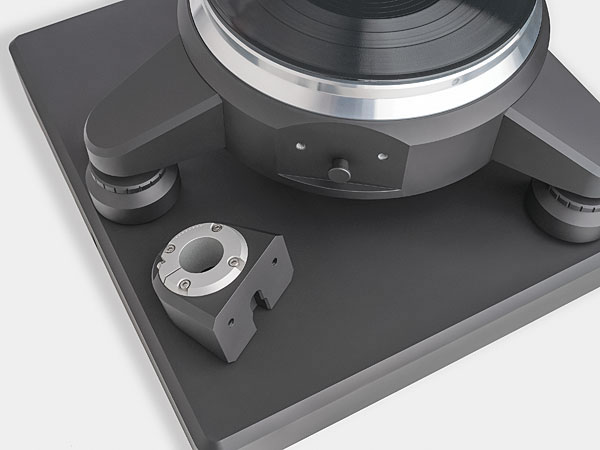
Gomez says that the inertial forces created by the unbalanced motors found in belt designs increase as the square of the rotational speed, which he says means they are more than 100 times greater in belt designs than what he measures in the direct-drive motor.
So, for instance, a typical belt-drive motor turning at 330rpm would have 10× the rotational speed of a direct-drive motor doing the same thing; the inertial forces, Gomez says, will be squared. That would mean that the vibrational characteristics of the XD1 motor are lower by a factor of more than 100. That, too, would be true of the "plain vanilla" SP-10R and probably your old SL-1200 as well.
Belt-drive advocates would counter that the belt does a very good job of isolating the platter from such vibrations. My opinion: The best examples of both technologies work very well.
What else is going on to bring the XD1's price—without a tonearm—to €150,000, or $177,435 at the current exchange rate as I write this? (Cynics will reply, "profiteering.") As with his tonearm designs (footnote 3).
Gomez seemingly suffers no price contraints in his efforts to increase rigidity and decrease unwanted vibrational energy. After all, what is vinyl playback but the transduction of vibrational energy into electrical energy? And what does the most damage to that transduction than the creation and/or transmission of extraneous vibrations?
The extensive mechanical and electrical modifications performed on the Technics motor elements include an all-new, internally mounted platform that greatly increases both system stability and isolation. There's a purpose-built, massive, three-point supporting bracket that provides "accurate, residual stress-free coupling." (We should all be so lucky.) The bracket connects to the turntable chassis through a high-area, friction-damped surface.
I remember, though not well, seeing in a presentation a comparison between the SP-10's stock motor's support system and the system Gomez has produced. The first seemed an afterthought; the second, a fortress.
A "preloading" system further increases the motor assembly's rigidity. The stator (the stationary part of the rotating system) couples rigidly to the chassis at three points above the motor bracket, adding a critical increase in stiffness. The couplings are preloaded after the motor is assembled in the turntable chassis and then locked, to maintain the settings indefinitely.
SAT also developed a motor-damping system, located at strategic points around the stator and said to reduce high-frequency vibrations that would negatively affect resolution. Because the damping causes the motor to vibrate less, it can more accurately rotate the platter. Gomez told me that the XD1's mechanical design is a "determinant factor in the resolution and dynamics conveyed by this turntable."
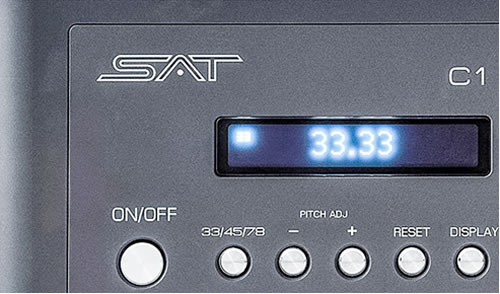
Gomez places the control electronics in an outboard chassis machined from a single block of aluminum, sitting on 10Hz-and-up isolation feet. This heavy chunk of machined aluminum must surely reduce airborne disturbances, and those feet will eliminate most structure-borne vibrations. Plus, the chassis complements the turntable's aesthetics.
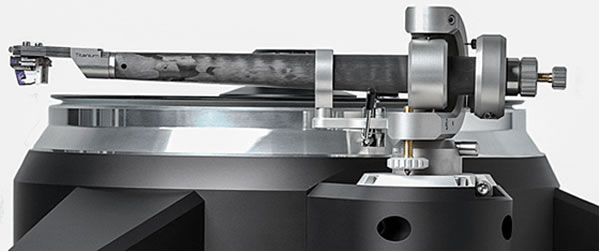
The tonearm supplied with the XD1 continues the original arm's CF1 designation; now it is either the CF1-9Ti (9") or the CF1-12Ti (12"). The 9" version I received appears outwardly identical to the original CF1 arm but adds a titanium tube running through the armtube; the original carbon-fiber armtube was already superstiff. In addition, the CF1's removable carbon-fiber headshell had been stiffened at the joint with an aluminum frame not found on the original SAT arm. In the new arm, the aluminium in that frame has been replaced by titanium.
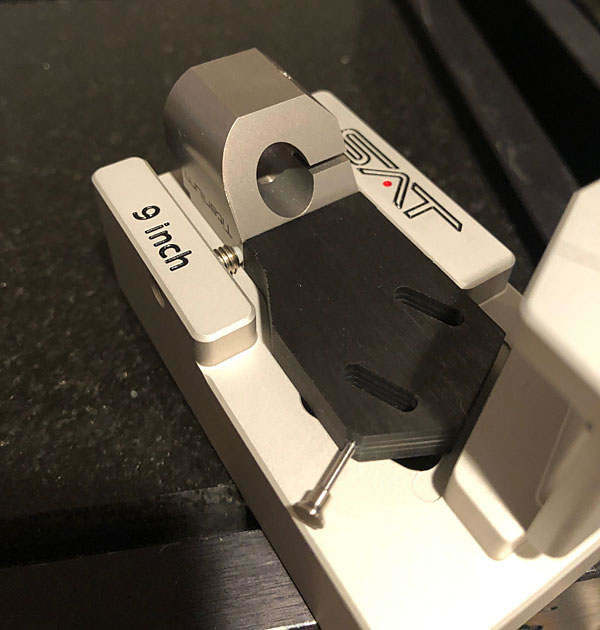
For buyers of the XD1, the additional stiffness comes at a moderately stiffer price. XD1 buyers pay €50,000 for the CF1-09Ti; at today's exchange rate, that's approximately $59,000. The standard CF1-09 costs about $56,000. Purchased separately—to install on your Rega P3, perhaps—the CF1-09Ti costs €76,000, or approximately $90,000. The 12" version, if you buy it with the turntable, costs €60,000 ($74,000), and if you buy it separately, €80,000 ($94,500). (Sorry, your Rega P3 can't accommodate a 12" arm.) The standard CF1-12 currently costs $71,000. The price difference reflects Gomez's priorities. He told me he prefers to sell the Ti arm to buyers of the XD1.
The isolation system, chassis, and tri-leg structure
The XD1's price includes a custom, low-profile, Minus K–based "negative stiffness" isolation platform—one of two components that constitute the turntable's dual-complementary isolation system (footnote 4).
The Minus K provides a very high level of isolation from 1.5Hz to 100Hz. Multielastomer-based suspension modules, matched to the turntable's mass and built into the XD1's three legs, provide isolation above 100Hz. They can be replaced with modules of different calibration if a heavier platter or tonearm becomes available. The feet also allow for precise platter leveling.
The high-density monoblock chassis, machined from a single piece of a magnesium-aluminum-silicon alloy, also provides isolation. Gomez says that several sharply machined edges along the chassis and leg contours diffract sound waves, reducing their sonic impact. Smaller curved, chamfered surfaces replace the large, flat surfaces found on most turntables.
The three massive legs were designed via Finite Element Analysis simulation and VDoE (Virtual Design of Experiments) technology, which you can learn more about on Google once you scroll past the Virginia Department of Education.
A unique armboard–turntable interface
A "key" type "drop in" system, stiffened with bolts, produces what Gomez claims is a 100% accurate, rigid interface between the two armboard "pods" and the side of the chassis. The design produces repeatably reliable geometry: With an arm and cartridge preinstalled on an extra armboard, you can install it in minutes and be sure of accurate alignment.
A platter matter
The XD1's standard platter weighs 26.5lb; the vacuum hold-down version weighs 33lb. Both are precision-machined from a "precipitation-aged Mg-Si-Al alloy" similar to what's used to produce the chassis. Both feature tall sections that "nest" the top platter and a flywheel ring of Swedish brass.
The platter/turntable interface is designed with a specific gap, intended to create a laminar flow for constant drag and more stable speed. A tiny, exacting gap between the platter rim and the chassis—which if you ever get to see in action is an act of machining precision few manufacturers would dare attempt—prevents air flow and exterior interference, keeping the air trapped between the platter and the chassis undisturbed.
The platter's top layer is made from a "proprietary advanced technical polymer infused with carbon-fiber micro powder and UHM carbon nanotubes," which "keeps magnetic field away from cartridge for maximum resolution (footnote 5) and provides levels of damping not possible with other material formulations." Also proprietary is a "special micro-ridge profile with controlled pitch and height, designed to provide unprecedented record coupling to the platter."
Most vacuum hold-down systems require air to pass through the spindle and bearing, which requires bearing modification, a seal, and in many systems, constant suction. Gomez opted for a passive system that is self-contained and requires no air to pass through the spindle and bearing (see Setup and use, below). SAT also provides a firm-coupling, smooth-operating, precision-adjustable record clamp.
The actuation mechanism—even the aluminum buttons—is designed and manufactured by SAT specifically for this turntable. SAT describes it as providing "a refined touch and a soft actuation with a silky smooth and delicate feedback." I can vouch for that. Considering the 'table's cost, buyers are entitled to an ultraprecise, sensuous-to-the-touch interface—and they get it.
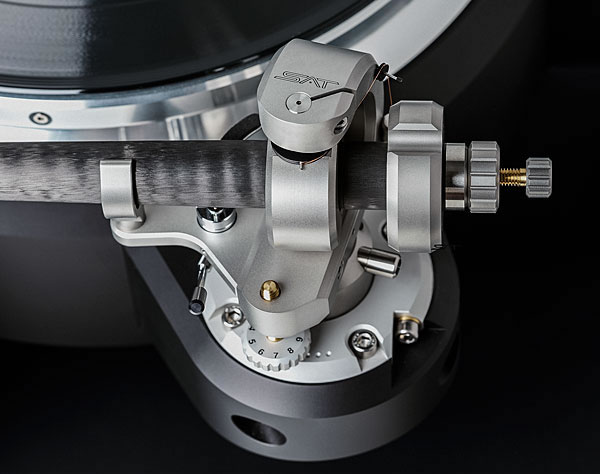
Setup and use
The XD1 was designed to be easy to install for one strong or two average-strength people. When you buy this costly turntable, a dealer will install it. Mine was installed by Maier Shadi of The Audio Salon in Santa Monica, California, SAT's American importer. I set up the cartridges of course: first the Ortofon MC Century, then the Lyra Atlas Lambda SL.
Here's how to use the vacuum hold-down system. SAT supplies a small vacuum pump housed in a matching black-anodized chassis, to which is attached a long piece of hose terminated with a metal nipple. Put a record on the platter, then flip the pump switch and insert the nipple into an elastomer-ringed outlet on the side of the platter. In about 10 or 15 seconds, the air is evacuated through tiny holes atop the platter. Then you just turn off the pump and screw on the clamp—or you can clamp first and then vacuum.
When the record side is finished playing, you insert a supplied mini-Torx screwdriver into a tiny release valve on the other side of the platter, allowing air back in via those tiny holes; you may now remove the record. SAT supplies a transparent platter cover to be used when you're not playing records, to keep it clean. I use a sticky roller to clean the platter before playing my first record of the day.
If you can afford the XD1, you can probably afford the extra €38,000 for the vacuum hold-down system, which brings the XD1's price, with a CF1-09Ti tonearm, to €238,000—or, in today's dollars, $281,970. That's about the same as a Lamborghini Huracán EVO Spyder, which seats two.
How does it sound?
When I reviewed the SP-10R in the OMA cast-iron plinth fitted with either the CF1-09 or Schröder CB arm and OMA's crystalline graphite mat, I wrote that it was the first turntable package since the Continuum Caliburn arrived an astonishing 15 years ago that I felt was almost its equal. It was an easy-to-recommend combination, especially given the considerable price difference, but it was not, ultimately, a Caliburn-beater.
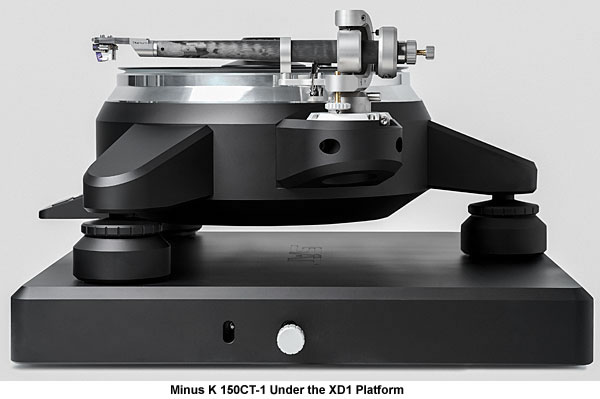
A few 'tables I've reviewed through the years have topped the Continuum Caliburn in one way or another, but none matched its combination of enticing sonic attributes, the ones that hooked me in the first place and kept me hooked for a decade and a half.
I've heard various XD1 iterations at shows and demos as Gomez refined his design. The earlier demos were underwhelming, especially considering the price. But one evening at Munich High End 2019, after hours, as I spun records that I'd shlepped halfway around the world for a crowd in the Marten Audio room, I said to myself, "That might be the best-sounding turntable I've ever heard!" One attendee later said it was the best evening of his life.
In my room at home, the fully finished XD1 whipped the Caliburn in every sonic way. Easily.
But before we get to that, look at the Platterspeed app's measurements SAT's: the XD1's are superior to even the SP-10R's. The variations in speed are smaller. The amplitude is lower in the low-pass–filtered green-line ripple. Can you hear what's illustrated there? I'm thinking so.

At first, for a few weeks, I simply enjoyed the XD1/CF1-09Ti combo with the Ortofon MC Century cartridge installed, hearing previously unheard bottom-end drive, extension, and tunefulness as well as seriously blacker backgrounds—something at which the Caliburn excelled. Virgil Fox-The Fox Touch (Crystal Clear CCS-7002 D2D) produced unmistakably superior and more muscular bass than I've ever heard here and an enormous soundstage that leapt out of the black.
Then I began a more methodical listen, keeping in mind that there are two variables here, the turntable and the tonearm (footnote 6). I played, and recorded in 24/96 PCM with my Lynx Hilo, a variety of tracks using the CF1-09/Lyra Atlas Lambda SL combo on the Caliburn, including the Alto Analogue Gil Evans masterpiece Out of the Cool (AA 008), The Ray Brown Trio's Soular Energy (Analogue Productions APJ-268-45), and an experimental 78rpm test pressing Classic Records produced in 1994 of an excerpt ("Troika") from Prokofiev's Lt. Kijé Suite (RCA LSC-2150), which Woody Allen used in his film Love and Death. (I think someone at last year's Florida Audio Expo fingered my 78rpm Pictures at an Exhibition. Please return it, no questions asked.)
Then I carefully moved the CF1-09 to the XD1's rear pod and made new recordings. That way I could directly and rapidly compare the Caliburn with the XD1. (Yes, these 24/96 files are good; no, they are not completely transparent to the source.)
Finally, I installed the Atlas Lambda SL on the CF1-09Ti and repeated the exercise. So now I had three versions of three tracks.
All of this only confirmed what I'd already heard, but now the CF1-09Ti tonearm's contribution was clear. Ray Brown's bass on "Teach Me Tonight" had a far more nimble and clean attack via the XD1 with either arm, as well as greater low-frequency extension and far faster and cleaner decay than the Continuum, which had an attractive, additive richness that by comparison sounded sluggish. No contest.
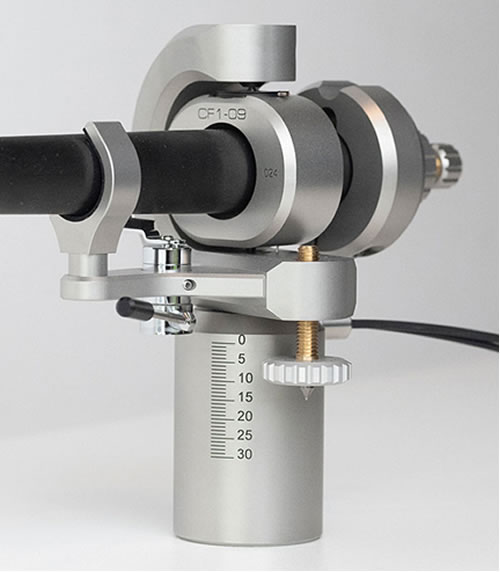
The Out of the Cool and Lt. Kijé recordings confirmed what I heard live: With either arm, both recordings were far better served—timbrally, dynamically, and in terms of transient precision—by the XD1. And the bass was in another league.
On the Kijé, a sonically spectacular sleigh ride (especially at 78rpm), there are some deep timpani accents that I've been familiar with for decades. Yes, the IsoAcoustics feet improved what I heard through the Caliburn (via my Wilson Alexx loudspeakers, where the feet are), but through the XD1 the timpani slams went deeper and were far better focused and better separated from the rear-wall reverb. Instead of a diffuse "rumble," there was a rapid-attack image, a quick sustain, and an effervescent decay. Each hit decayed more quickly, which made them sound more real and less recorded. Their intensity surprised and startled compared to what I'd become accustomed to.
Was the XD1 merely a brash attacker, stingy with sustain and harmonic structure? Any fears I had of that were alleviated on the opening cymbal crash, which was sharp, explosive, and long-tailed, and via the "oompah" tubas and mellow horns that announce the young lieutenant. The timbral contrasts between the warm horns and the bright cymbals were greater than I can recall ever hearing on this recording.
The fast-moving "sleigh ride" section Allen used in his film features pizzicato strings, triangle, tambourine, sleigh bells, oboe, and finally a piccolo stating the theme. Comparing the three depictions of this section, the Continuum's was the warmest, the thundering timpani mushier and less well-defined, the cymbal crashes softer, and little evidence of the pressure wave produced by the air forced out from between the cymbals (something I'd not previously experienced before the XD1).
Through the Continuum, the pizzicato strings were softer and the triangle more velvety than metallic, with the individual strikes blending together. The oboe, too, was softer, and it lacked definition and presence. All this is in comparison, using a sonic magnifying glass.
All of this musical action was better defined in every way on the XD1, with either arm: wider dynamics, increased extension, superior timbral definition and resolution of inner detail. All of that was improved a few weeks ago when I installed the IsoAcoustics feet. Now it was magnified in intensity by the XD1.
Knowing the XD1 would be broken down and crated in a few days, I spent the final few evenings, well past 2 a.m., listening to as many familiar records as possible, each a new experience—producing not just previously hidden details but, in most cases, entirely new listening experiences.
That's not hyperbole. Decades of playing XTC's 1982 double-LP masterpiece English Settlement (UK Virgin V2223) on the four fine turntables I've owned since 1982 (Oracle Delphi, VPI TNT, Simon Yorke S7, and Continuum Caliburn) have left an indelible sonic impression: monster earthquake bass and drum thwacks in front of a hazy reverb envelope starting with the opening track, "Runaways," and continuing through "Ball and Chain," "Senses Working Overtime" (the single), and the pounding "Jason and the Argonauts." I know we're supposed to have short audio memories, but I can definitely hear drummer Terry Chambers pleasantly overwhelming the sonic picture on "Senses Working Overtime," as Andy Partridge sings "And I've got one, two, three, four, five ... senses working overtime." It's not until the breezy "Yacht Dance" on Side 2 that Chambers lays back so that you can hear his kit cleanly. On that track, it's Colin Moulding's bass that overwhelms.
Adding the SAT tonearm to the Caliburn tamed this picture somewhat. Then, on the SAT 'table, every drum and bass element was in its place for the first time—ever. They were smaller, deeper, far more powerful, and controlled; the attack, sustain, and decay occurred on time. This allowed previously overwhelmed, blurred, and buried instruments to emerge in a clarified mix that produced greater musical excitement and zero listening fatigue.
A (masked) friend came over with preconceived notions about how some of his favorite albums should sound. All of them were shattered. We compared the SAT to the Caliburn on "Norwegian Wood," from an original UK pressing. When Lennon sings "She asked me to stay and she told me to sit anywhere," Ringo pounds his bass drum. The SAT 'table produced tight, insistent hits. The Caliburn's were soft and far less well defined.
The XD1 shares some sonic characteristics with Rega's revolutionary RP10 turntable: ultrafast, clean transients throughout the audible frequency range; tight, fast bass; revealing midrange transparency; and overall sonic stability and focus. All these characteristics result, apparently, from careful attention paid to structural rigidity and the removal or prevention of unwanted vibrational energy.
As good as the P10 is, it's not an SAT XD1. (Nor is the SL-1200, despite the fanboy adulation.)
Conclusion
Antivinyl audiophiles who have gotten this far are shaking their heads in disbelief that anyone would spend this amount of money to hear an old technology that they are certain is nothing but rumble, pops, clicks, and constricted dynamics. But the rest of us know the magic produced when old, familiar records get played on an upgraded analog front end. Nothing in the digital world compares to the experience—at least in my experience.
Everyone has experienced an upgrade where familiar music's meaning, long hidden in plain sight, suddenly gets exposed. The XD1 did that consistently. I'm still hearing in my head the XD1's playback of Eno's Taking Tiger Mountain (By Strategy) (ILPS 9309) and Bowie's Station to Station (RCA APL1-1327), thinking, "I've really just heard those records for the first time. Oh, there's a second musical event hiding behind the familiar first one that I used to think was all that was there."
There's more than one contender for best-sounding, best-built turntable in the world. Another stratospherically priced one is arriving in a few days, and still another is scheduled for 2021, COVID-19 (or a vaccine) willing. For now, though, sleep deprivation makes clear that the SAT XD1 with CF1-09Ti is the best-sounding, best-engineered, and best-built turntable that's been here. I'm so glad that I'm still here to experience it!
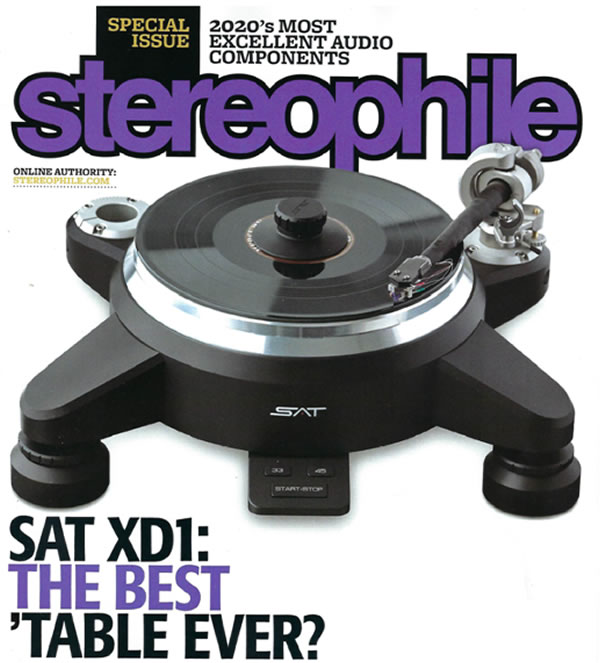
Footnote 1: Swedish Analog Technologies, Gothenburg, Sweden. Tel: (46) 736 846 452. Web: www.swedishat.com.
Footnote 2: To learn more about the stock SP-10R, see my interview with Technics CTO/Chief Engineer Tetsuya (Tony) Itani, which I conducted at the 2017 Tokyo Audio Show when the SP-10R was still in prototype.
Footnote 3: You can read about Gomez's approach to designing tonearms in the review of his original arm here.
Footnote 4: You can read an interview with the inventor, Dr. David Platus here.
Footnote 5: In an email exchange, Gomez pointed out to me—it's true!—that even nonmagnetic conductors interact with a magnetic field, if it's moving. Try moving a magnet past an aluminum can suspended from a string—or search for "Lenz effect" on YouTube.—Editor
Footnote 6: In a way, there's a third: my system's forward leap in performance when I installed the IsoAcoustics footers and the CAD Ground Control units.
|